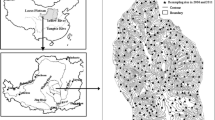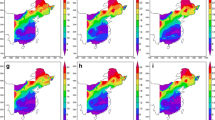Abstract
Land use change can have a strong impact on soil carbon dynamics and carbon stocks in urban areas. Due to rapid urbanization, large areas of land have been paved, and other areas have undergone rapid land use change. Evaluation of the impact of urbanization on carbon dynamics and carbon stock (30 cm) has become an issue of urgent concern. The soil carbon dynamics, due to rapid land use change in Tianjin Binhai New Area of China, have been simulated in this paper using the RothC model. Because this area is saline, a modified version of RothC that includes a salt rate modifier provided more accurate simulations than the original model. The conversion to urban green land was not accurately simulated by either of the models because of the undefined changes in soil and plant conditions. According to the model, changes of arable to grassland resulted in a decline in soil carbon stocks, and changes of grassland to forest and grassland to arable resulted in increased soil carbon stocks in this area. Across the whole area simulated, the total carbon stocks in 2010 had decreased due to land use change by 6.5% from the 1979 value. By 2050, a further decrease of 21.9% is expected according to the 2050 plan for land use and the continuing losses from the soils due to previous land use changes.
Similar content being viewed by others
References
Batjes N H. Total carbon and nitrogen in the soils of the world. European Journal of Soil Science, 1996, 47(2): 151–163
Houghton R A, Skole D L. Carbon. In: Turner B L, Clark W C, Kates R W, Richards J F, Mathews J T, Meyer W B, editors. The Earth as Transformed by Human Action. New York: Cambridge University Press, 1990
Smith P. Soils as carbon sinks-the global context. Soil Use and Management, 2004, 20(2): 212–218
Smith P. Land use change and soil organic carbon dynamics. Nutrient Cycling in Agroecosystems, 2008, 81(2): 169–178
Watson R T, Noble I R, Bolin B, Ravindramath N H, Verardo D J, Dokken D J. Land Use, Land-Use Change, and Forestry (A Special Report of the IPCC). Cambridge: Cambridge University Press, 2000
IPCC. Climate Change 2001:Working Group I: the Scientific Basis. New York: Cambridge University Press, 2001
Houghton R A. Why are estimates of the terrestrial carbon balance so different? Global Change Biology, 2003, 9(4): 500–509
Pouyat R, Groffman P, Yesilonis I, Hernandez L. Soil carbon pools and fluxes in urban ecosystems. Environmental Pollution, 2002, 116(Suppl 1): S107–S118
Jenkinson D S, Adams D E, Wild A. Model estimates of CO2 emissions from soil in response to global warming. Nature, 1991, 351(6324): 304–306
Parton WJ, Scurlock JMO, Ojima D S, Gilmanov T G, Scholes R J, Schimel D S, Kirchner T, Menaut J C, Seastedt T, Garcia Moya E, Kamnalrut A, Kinyamario J I. Observations and modeling of biomass and soil organic matter dynamics for the grassland biome worldwide. Global Biogeochemical Cycles, 1993, 7(4): 785–809
Falloon P, Smith P, Szabó J, Pásztor L. Comparison of approaches for estimating carbon sequestration at the regional scale. Soil Use and Management, 2002, 18(3): 164–174
Shirato Y, Yokozawa M. Applying the Rothamsted carbon model for long-term experiments on Japanese paddy soils and modifying it by simple tuning of the decomposition rate. Soil Science & Plant Nutrition, 2005, 51(3): 405–415
Gupta R, Abrol I. Salt-affected soils: their reclamation and management for crop production. Advances in Soil Science, 1990, 15(11): 223–288
Szabolcs I. Soils and salinaizatio. In: Pessarakli M, ed. Handbook of Plant and Crop Stress. New York: Marcel Dekker, 1993
National Soil Survey Office. Chinese Soil Genus Records (Vol. 3). Beijing: China Agriculture Press, 1995
Powlson D S, Smith P, Smith J U. Evaluation of soil organic matter models using existing long-term datasets. In Coleman K, Jenkinson DS, eds. RothC-26.3-A Model for the Turnover of Carbon in Soil. Michigan: Springer-Verlag, 1996
Setia R, Smith P, Marschner P, Baldock J, Chittleborough D, Smith J. Introducing a decomposition rate modifier in the Rothamsted carbon model to predict soil organic carbon stocks in saline soils. Environmental Science & Technology, 2011, 45(15): 6396–6403
FAO. FAO-Unesco Soil Map of the World. Vol 1. Legend. Paris: Unesco, 1974
Tang T G. The Coastal Halophilous Plants of Tianjin. Beijing: China Forestry Press, 2007 (in Chinese)
Xu N, Gao D M. Wetlands of Tianjin. Tianjin: Tianjin Scientific and Technology Press, 2008 (in Chinese)
Nelson D W, Sommers L E. Total carbon, organic carbon, and organic matter. In: Page A L, ed. Methods of Soil Analysis. Part 2. 2nd ed. Madison: ASA and SSSA, 1982
Falloon P, Smith P, Coleman K, Marshal S. Estimating the size of the inert organic matter pool from total soil organic carbon content for use in the Rothamsted carbon model. Soil Biology & Biochemistry, 1998, 30(8–9): 1207–1211
Nieto O M, Castro J, Fernández E, Smith P. Simulation of soil organic carbon stocks in a Mediterranean olive grove under different soil-management systems using the RothC model. Soil Use and Management, 2010, 26(2): 118–125
Ludwig B, Hu K, Niu L, Liu X J. Modelling the dynamics of organic carbon in fertilization and tillage experiments in the North China Plain using the Rothamsted carbon model-initialization and calculation of C inputs. Plant and Soil, 2010, 332(1–2): 193–206
Setia R, Marschner P, Baldock J, Chittleborough D, Smith P, Smith J. Salinity effects on carbon mineralization in soils of varying texture. Soil Biology and Biochemistry, 2011, 43(9): 1908–1916
Smith J, Smith P, Addiscott T. Quantitative methods to evaluate and compare soil organic matter (SOM) models. In: Powlson DS, Smith P, Smith JU, eds. Evaluation of Soil Organic Matter Models-Using Existing Long-Term Datasets. Heidelberg: Springer, 1996
Smith P, Smith J U, Powlson D S, McGill W B, Arah J R M, Chertov O G, Coleman K, Franko U, Frolking S, Jenkinson D S, Jensen L S, Kelly R H, Klein-Gunnewiek H, Komarov A S, Li C, Molina J A E, Mueller T, Parton W J, Thornley J H M, Whitmore A P. A comparison of the performance of nine soil organic matter models using datasets from seven long-term experiments. Geoderma, 1997, 81(1-2): 153–225
Smith J, Smith P, Wattenbach M, Zaehle S, Hiederer R, Jones R J A, Montanarella L, Rounsevell M D A, Reginster I, Ewert F. Projected changes in mineral soil carbon of European croplands and grasslands, 1990–2080. Global Change Biology, 2005, 11(12): 2141–2152
Liu L M, Shi F C, Yu J. Study on the estimation and application of wild plants in seashore area of Tianjin. Chinese Landscape Architecture, 2011, 12(10): 70–73 (in Chinese)
Mann L K. Changes in soil carbon storage after cultivation. Soil Science, 1986, 142(5): 279–288
Davidson E, Ackerman I. Changes in soil carbon inventories following cultivation of previously untilled soils. Biogeochemistry, 1993, 20(3): 161–193
Smith P, Powlson D S, Smith J U, Falloon P, Coleman K. Meeting Europe’s climate change commitments: quantitative estimates of the potential for carbon mitigation by agriculture. Global Change Biology, 2000, 6(5): 525–539
Lal R. Residue management, conservation tillage and soil restoration for mitigating greenhouse effect by CO2-enrichment. Soil & Tillage Research, 1997, 43(1–2): 81–107
Liu D L, Chan K Y, Conyers MK. Simulation of soil organic carbon under different tillage and stubble management practices using the Rothamsted carbon model. Soil & Tillage Research, 2009, 104(1): 65–73
Author information
Authors and Affiliations
Corresponding author
Rights and permissions
About this article
Cite this article
Hao, C., Smith, J., Zhang, J. et al. Simulation of soil carbon changes due to land use change in urban areas in China. Front. Environ. Sci. Eng. 7, 255–266 (2013). https://doi.org/10.1007/s11783-013-0485-4
Received:
Accepted:
Published:
Issue Date:
DOI: https://doi.org/10.1007/s11783-013-0485-4




